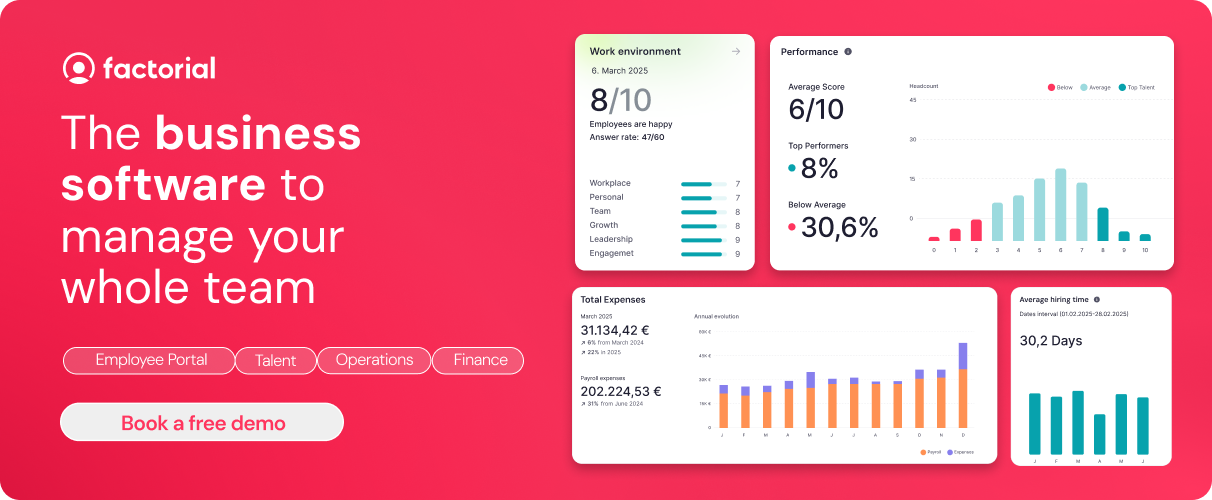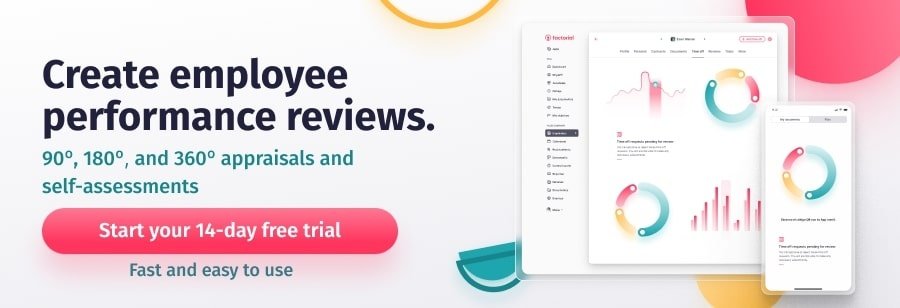Stack ranking is a forced ranking performance management system where you measure employee performance against that of your entire workforce, rather than your established individual performance standards. In its traditional form, you reward the top 20% of performers and fire the bottom 10%.
This employee performance management method is considered controversial by many people. Supporters argue that a “rank and yank” approach motivates employees to perform better and clearly identifies underperformers. However, those against the approach claim that it creates an unhealthy culture that discourages cooperation and impacts employee morale. Despite this fact, thirty percent of Fortune 500 companies are said to use stacked ranking to evaluate their employees.
In this post we are going to take a look at the forced ranking performance evaluation system and why it can often be a problematic method for staff evaluations. We will also share a few stack ranking examples and discuss alternatives that can help you rank the performance of your employees in a fairer and more effective way.
TABLE OF CONTENTS
- What is Stack Ranking?
- Problems with Stack Ranking
- Stack Racking Examples: Companies That Use Forced Ranking
- What is a Good Alternative to Stack Ranking?
- How to Rank Employee’s Performance
- FAQ About Stack Ranking
- Drive Growth Through Performance Reviews With This Software ✅
What is Stack Ranking?
Stack ranking, also known as forced ranking, rank and yank, and the vitality model, is an HR ranking system used to rank and grade an employee’s performance. This controversial method differs from other systems such as pay for performance or 9 box methods for optimizing performance.
With a forced ranking system, instead of evaluating performance against established employee performance metrics, standards, and expectations set by individual performance improvement plans, employee performance is measured against that of all other employees within the organization.
The typical structure of a forced ranking performance evaluation system is based on dividing employees into three groups:
- A group: the “top” 20% who are the highest performers. These are your most engaged, motivated, committed and productive employees. You reward this group with raises, stock options, and training.
- B group: the “middle” 70% who are not as engaged or motivated, but still important to your company’s success. You might reward this group with smaller raises and encourage them to improve.
- C group: the “bottom” 10% are your least performing employees. You don’t reward this group with raises, bonuses or training, and you may fire them for underperforming.
Problems with Stack Ranking
A stack ranking performance review system can help large organizations to systemize their HR processes. It can help you identify top performers, and increase productivity, profitability, and shareholder value.
But stack ranking employees can also be risky and controversial if you don’t implement a clear and balanced strategy.
Here are some of the downsides of relying on a system of stack rankings:
- A stack rank performance ranking system can have a hugely negative impact on employee morale and engagement. You are basically telling your employees that, no matter how hard they work, if their colleagues work harder then they might end up in the bottom 10% group and lose their jobs. This can make your employees feel unmotivated and disengaged. A staff ranking system can also create an unhealthy culture based on unnecessary internal competition. And this can lead to a lack of synergy that can destroy any sense of creativity and innovation in your company.
- How do you measure the bottom 10%? Do you compare employees to all other individuals in your company with your stacked rank, or to performance within their own departments only? How do you compare the value of one department with another? Unless you have a clear definition of “high performance” within your company ranking system and a way of measuring revenue per employee, you run the risk of relying on subjective assessments that are open to bias.
- A forced ranking performance appraisal also doesn’t take into account the factors that might be having an impact on performance. Are you offering all your employees the training they need to perform well? Are your managers keeping their teams motivated?
Say goodbye to chaos with smarter Business Management Software.👇

Stack Racking Examples: Companies That Use Forced Ranking
These days, more and more companies are realizing the benefits of looking at the individual circumstance of all their employees, rather than separating them into arbitrary ranking scores. It’s all about what they do every day, how they view the company, how they work within their teams, what they contribute to strategic goals, and what keeps them motivated.
Nonetheless, let’s take a look at a few well-known examples of companies that have used, or are still using, a stack ranking approach to measure the performance of employees.
GE Forced Ranking System
If we are going to talk about stack ranking, then we have to start with one of the most famous pioneers of the practice: General Electric.
Former CEO Jack Welch created the company’s “Vitality Curve”, which he claimed contributed to GE’s revenues almost doubling in the 1980s and 1990s. Welch created the concept of forced ranking because he believed that the company had become too big and too comfortable. He also argued that GE wasn’t effectively measuring employee performance, resulting in a lack of motivation. He wanted to encourage his staff to work harder, or risk being fired.
GE has since moved away from its rank and yank philosophy, favoring a more modern approach to performance management and salary review that offers more performance appraisal benefits for employees.
Amazon Stack Ranking
Amazon has relied on stack ranking in the past to evaluate employee performance. However, instead of firing underperformers, the company took them on a 3-month “Performance Improvement Plan,” to help them get back on track.
These days, Amazon has tried to distance itself from the negative reputation associated with stack ranking, and it now focuses on more of a continuous feedback approach.
Microsoft Stack Ranking
Microsoft is another corporate giant that is famous for using forced ranking as its preferred performance management practice. The company asked its managers to rank their teams on a scale from top to poor performers. They would give 2 out of 10 employees a great review, 7 out of 10 an adequate review and 1 employee a terrible review. However, this system had a negative impact on growth, motivation and innovation. They, therefore, scrapped it in 2012.
Google Employee Ranking System
Google has implemented a modern twist on the traditional forced ranking method. It relies on slack ranking to highlight candidates that are ready for promotion. There is no negative impact if an employee ranks in the bottom 10%. It is just a tool for promotions.
Instead, when it comes to performance, they use an internal grading system known as Objectives and Key Results, or OKRs. These OKRs are not directly related to performance evaluation but to monitor progress and accomplishments.
Google uses two methods to measure performance: self-assessment and 360-degree feedback.

What is a Good Alternative to Stack Ranking?
Stack ranking can be a powerful performance management tool, but if you use it, you should do so with caution. If you don’t follow the right strategy, then it can negatively impact your productivity levels and your overall workplace culture.
A much more effective performance management system relies on a more modern approach. Instead of pitting your employees against each other, as with forced ranking, focus on undertaking regular employee performance reviews in order to actively nurture company growth in a healthy and balanced way. Create employee recognition programs and fairer performance reviews for remote employees. This will help you create a high-performance culture made up of motivated and happy individuals.
Ultimately, you need to work on creating opportunities for development, fostering a culture of dialogue and communication, and supporting your employees so that they can reach their goals. In other words, you need to find ways to create a supportive but challenging workplace that encourages professional growth. And this means creating a culture of continuous feedback.
How to Rank Employee’s Performance
One of the most effective methods for getting a reliable evaluation of an employee’s performance is to implement a system for continuous performance management.
Continuous performance management (CPM) tracks each employee’s progress toward the company’s overall objectives on an ongoing basis. The aim is to identify areas for improvement and encourage employees to continuously develop their skills.
CPM is based on the principles of continuous analysis, agile management, and real-time feedback. You set performance standards for your employees and help them meet their goals. You then assess their performance on a regular basis in line with these goals and expectations. This enables you to identify any issues before they become a problem.
The most important aspect of CPM is maintaining regular reviews and appraisals. Unlike a traditional stack ranking system, CPM creates an opportunity for open dialogue and discussion. This creates a culture of open two-way dialogue and encourages employees to take responsibility for their own professional development.
An important aspect of this is creating a culture of 360 feedback. This gives you access to valuable real-time data from every perspective and at every level of your company. A great place to start is by using Factorial’s 360 Performance Assessment. This evaluation helps you understand how each employee is performing and the impact they are having on the overall success of your business.
FAQ About Stank Ranking
1. What is stack ranking?
Stack ranking is a performance evaluation system where employees are ranked against each other rather than against established performance standards.
2. How are employees categorized in stack ranking?
Employees are divided into three groups: A group (top 20% performers), B group (middle 70%), and C group (bottom 10%).
3. What are the key problems with stack ranking?
Stack ranking can negatively impact employee morale, create unhealthy competition, and rely on subjective assessments.
4. How do companies like GE, Amazon, and Microsoft use stack ranking?
GE pioneered it but moved away from it. Amazon used it but shifted to a continuous feedback approach. Microsoft used it until 2012 but scrapped it due to negative impacts.
5. What is Google’s approach to employee ranking?
Google uses a modified version for promotions and focuses on Objectives and Key Results (OKRs) for performance monitoring.
6. What is a good alternative to stack ranking?
A more modern approach like continuous performance management (CPM) focuses on regular reviews, employee development, and creating a culture of continuous feedback.
7. How does continuous performance management work?
CPM tracks employee progress towards company objectives continuously, using principles of continuous analysis, agile management, and real-time feedback.


